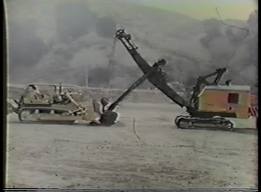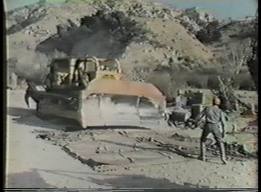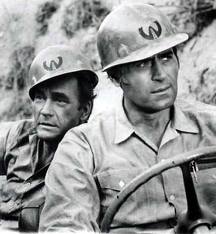You're out of the woods, You're out of the dark, You're out of the night.
Step into the sun, Step into the light.
Keep straight ahead for the most glorious place
on the Face of the Earth or the Sky.
Hold onto your, breath, Hold onto your heart, Hold onto your Hope.
-The Wizard of Oz
1939
Tired of the everyday grind? Want to lead a life of romantic adventure? We offer you...Escape!
-40's radio show Escape introduction
It's 1939. After 10 years of the most harsh economic conditions in the country's history and with war clouds gathering overseas in Europe, Americans just want to escape it all. Escape to a heavenly paradise devoid of failing financial institutions, dust bowls, famine, war and the like. Escape to a place that is always colorful and gay. Escape to a place that, well, looks something like this:
In the late summer of 1939, The Wizard of Oz was released to a public whose voracious appetite for escape from reality had been the driving force in the production of nearly a hundred movie musicals over the course of the downtrodden decade. But the happy-go-lucky talkies were only a temporary respite from the world's miseries which seemed only to be multiplying. Was there a more permanent form of escape? Possibly a taboo one that no one talked about? With a path that only the most courageous (or foolhardy) would attempt?
It's now 2012. The world's financial institutions are crumbling, there are endless wars and the misery index soars ever higher. But there are also endless avenues of escape available. From the Soma holidays provided by pharmaceuticals and illicit drugs, to religious cults, to the internet rabbit hole, to personal hobbies, projects and causes, there seem limitless paths to escape. And our old friend, the movie musical, who's death was prematurely reported in the late 70's, is actually still very much alive and kicking, offering more paths to escape than ever. In the first decade of the new millennium, 742 musicals were produced world-wide, that's over seven times the number produced in the 30's. Escapism in the old days used to be limited to Friday nights at the picture show or maybe weekend walks through the countryside. Today, the amount of time committed to escape and the proliferation of escape routes is ever increasing with more and more time spent in an alternate reality. We really want to be elsewhere in the worst way. Can this be healthy, or will it ultimately lead to insanity or even death?
Synopsis - In 1940, over 500 people from the town of Friar, New Hampshire leave their homes and walk up an ancient trail. Some are found frozen, some are found dismembered but most simply disappear. A modern-day researcher gathers a team to follow the old trail nicknamed YellowBrickRoad.
Horror and mystery stories are like magic tricks, once you know the secret or McGuffin, they lose their allure. There are rare examples of stories that never reveal the source of the mystery, but they tend to be eschewed by the mainstream who would rather have a concrete monster, serial killer or other tangible thing as an explanation. In my case, I don't want to know the hidden mystery or terror. It makes for a much more interesting story and often sparks interesting debate. An example taken from real life would be the case of the Mary Celeste. The Mary Celeste was an American brigantine merchant ship found adrift and unmanned on December 4, 1872. The ship had no damage, ample supplies and none of the crew's personal effects seemed to be missing. There was nothing to indicate a problem in the captain's log and everything else seemed normal except for one missing lifeboat.
Reading through the theories and possible explanations of what happened to the crew of the Mary Celeste is fascinating, but I'd never want a definitive explanation or proof of what actually happened. It would make the story much less intriguing. But that's just me.
In YellowBrickRoad, there's an unsettling scene at the outset involving the protagonist, Teddy Barnes (Michael Laurino), the lead researcher who it is implied is more than just a little obsessed with the mysterious disappearance of the residents of Friar, NH in 1940. A strange clerk behind opaque glass gives him previously sealed documents concerning the disappearances, apologizes for the previous inconvenience and oddly tells him to "enjoy the picture show". There's a weird "be careful what you wish for" aspect to this scene that drew me right into the movie. Such odd little details, moments and behaviors are carefully scattered throughout the film by the writing and directing team of Jesse Holland and Andy Mitton which make it a denser, more meaningful and disturbing story than it would appear on the surface. The era the disappearances take place in is also thematically relevant. They could have been written to occur at any time after the 40's but the filmmakers chose a very specific year for a reason. Just as they picked the original trail head of the Yellow Brick Road to be Friar's modern day movie theater, the Rialto, which still contains a worn to useless print of The Wizard of Oz and has marquee titles displayed that seem a little to relevant to the proceedings to be random movie titles. I love throwaway details like this that not only make repeat viewings enjoyable but almost mandatory.
After informing his wife and teaching colleague that he's been given the previously classified documents concerning the disappearances, Teddy gathers a professional crew to go on the woodland trek who aren't just a bunch of dumb college kids out for a lark, but a serious research group with specific jobs and expertise. There's a brother/sister team of cartographers, a forest ranger, a medical intern and even a psychologist in addition to Teddy and his wife.
The use of the far-off music was a unique and effective tool to show the group's ever spiraling decent into madness. Initially, it seems benign or even enjoyable despite being unexplainable, but as it continues on, it becomes ever more disturbing and seems to mock the characters as they push forward. This device could easily become something more annoying than scary to the viewer, but it is actually much more unsettling than the description would imply. The filmmakers seemed to understand just when to pour on the music and reality tearing sound effects and when to step away from this tool without becoming gimmicky. It is infinitely more effective than scary music stings imbedded in the soundtrack or even altered reality visual cues.
The slow mental disintegration is nicely executed with a combination of solid acting and clever direction. The scene in which the brother and sister tousle is shot from a distance from another character's POV through shakily held binoculars so that it takes time for the viewer to figure out how bad the situation becomes. This allows for additional tension that would not have been generated in a more conventional and overly shot scene. Another scene involving the discovery of a posed dead body is similarly effective because it is shot from a distance and it again takes the viewer time to catch up with the horror.
While the team seems to be suffering the same fate as the original townspeople who walked the trail, Teddy presses on only to discover he has been Mobius stripped right back to the trails head - back at Friar's Rialto movie theater with an usher character who is the same incarnation of evil as the original clerk who gave Teddy the secret documents at the beginning of the story. Teddy then watches a vision of hell play out on the theater's screen with his deserted wife. In essence, he's chosen the escape of his personal project over his wife and friends and is forced to see the ultimate consequence of his decision.
It's not the most accessible message which may explain the wildly mixed reviews I've read from critics and posters. Also, I think another problem people have with the film is the lack of a clearly drawn or overt McGuffin. Most viewers just don't like ambiguity or the unexplained. I enjoyed both the theme, the vagueness and the execution of the film. Clearly, the writer/directors, Holland and Mitton, put some real thought into the script and concept. It would have been the easiest thing in the world for them to make another 'slasher in the woods' type tale or have some other easily accessible story device. I'm glad they didn't go down that trail.
After informing his wife and teaching colleague that he's been given the previously classified documents concerning the disappearances, Teddy gathers a professional crew to go on the woodland trek who aren't just a bunch of dumb college kids out for a lark, but a serious research group with specific jobs and expertise. There's a brother/sister team of cartographers, a forest ranger, a medical intern and even a psychologist in addition to Teddy and his wife.
 |
| Cartographers Erin and Daryl Luger |
 |
| Ranger Cy Banbridge |
 |
| Psychologist Walter Myrick and Melissa Barnes |
 |
| Jill the intern |
 |
| Team leader Teddy Barnes |
In addition, they pick up another member of the team from Friar, a movie theater employee named Liv McCann who desperately wants to escape town but is frustratingly vague as to why. She agrees to show Teddy and his team the trail if they take her along.
 |
| Liv McCann |
Initially all goes well for the group and morale is high as they make their way through the woods. There is even some good natured teasing between the siblings over a found grubby hat and a running joke with 'Jill the intern' about her hopelessly useless GPS device which variously shows their locations as Italy, Australia, Guam or other exotic locations. But, of course, things go downhill as the group gets deeper into the woods and begins to hear music from the 30's being played in the distance which gets louder and more discordant the further along the trail they get.
The slow mental disintegration is nicely executed with a combination of solid acting and clever direction. The scene in which the brother and sister tousle is shot from a distance from another character's POV through shakily held binoculars so that it takes time for the viewer to figure out how bad the situation becomes. This allows for additional tension that would not have been generated in a more conventional and overly shot scene. Another scene involving the discovery of a posed dead body is similarly effective because it is shot from a distance and it again takes the viewer time to catch up with the horror.
Warning: Massive spoiler alert
While the team seems to be suffering the same fate as the original townspeople who walked the trail, Teddy presses on only to discover he has been Mobius stripped right back to the trails head - back at Friar's Rialto movie theater with an usher character who is the same incarnation of evil as the original clerk who gave Teddy the secret documents at the beginning of the story. Teddy then watches a vision of hell play out on the theater's screen with his deserted wife. In essence, he's chosen the escape of his personal project over his wife and friends and is forced to see the ultimate consequence of his decision.
It's not the most accessible message which may explain the wildly mixed reviews I've read from critics and posters. Also, I think another problem people have with the film is the lack of a clearly drawn or overt McGuffin. Most viewers just don't like ambiguity or the unexplained. I enjoyed both the theme, the vagueness and the execution of the film. Clearly, the writer/directors, Holland and Mitton, put some real thought into the script and concept. It would have been the easiest thing in the world for them to make another 'slasher in the woods' type tale or have some other easily accessible story device. I'm glad they didn't go down that trail.
Score 8/10
















